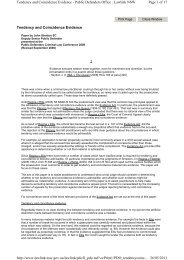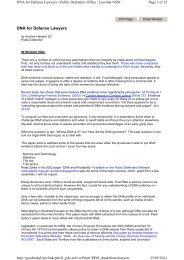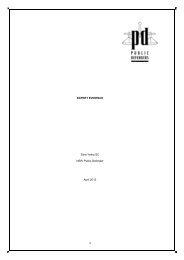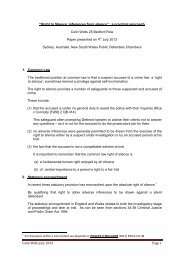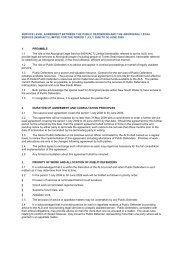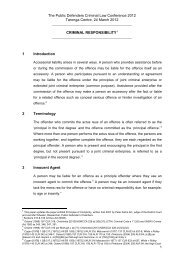DNA for NJC - The Public Defenders
DNA for NJC - The Public Defenders
DNA for NJC - The Public Defenders
Create successful ePaper yourself
Turn your PDF publications into a flip-book with our unique Google optimized e-Paper software.
evidence has been considered on many occasions, but the specific issue has not been<br />
decided at the appellate level. 30<br />
Victoria’s Court of Appeal, similarly, has held that <strong>DNA</strong> profiling establishes no more than<br />
that the accused could be the offender. 31 This point is taken up in Victoria’s Judges’ Bench<br />
Notes. 32 Although I note these did not prevent Mr Jama’s conviction. In South Australia their<br />
Court of Appeal has dismissed appeals where <strong>DNA</strong> was the only evidence of the identity of<br />
the offender. 33 This is despite the direction from an earlier and authoritative decision of that<br />
court that a jury can only convict if the <strong>DNA</strong> is evaluated in the context of all the other<br />
evidence. 34<br />
In England there is no principle of law that <strong>DNA</strong> evidence of itself is incapable of proving<br />
guilt. 35 <strong>The</strong>re is no rule about when it is safe to leave statistical calculations to a jury. 36 A<br />
judge can however instruct a jury that where the <strong>DNA</strong> evidence stands alone they could not<br />
convict. 37 <strong>The</strong> significance of the <strong>DNA</strong> depends on the evidence in the individual case and<br />
how it is to be assessed depends critically upon what else is known about the accused. 38<br />
United States courts have rejected the idea that <strong>DNA</strong> evidence alone cannot convict. 39 <strong>DNA</strong><br />
evidence treated as highly reliable and better than visual identification evidence. However, it<br />
has been recognised that <strong>DNA</strong> often fails to provide the absolute proof it promises. 40<br />
Cases where <strong>DNA</strong> is the sole evidence of identity are coming be<strong>for</strong>e the courts and there<br />
have been demonstrated miscarriages of justice. How then are we to ensure fair trials? One<br />
response is to say: If <strong>DNA</strong> evidence is properly collected and observed and an expert,<br />
properly qualified, gives evidence of the analysis and results, that evidence should be<br />
admissible and a jury (or judge as fact finder) should be entitled to rely on that conclusion, as<br />
occurs with evidence of visual and voice identification and fingerprints. If any “additional”<br />
30 <strong>The</strong> question was raised recently in Talay v R [2010] NSWCCA 308 but the appeal was dismissed on procedural grounds. At<br />
[65] Howie AJ, in an obiter comment, said he did not believe there was merit in the application.<br />
31 R v Noll [1999] 3 VR 704 at [25.<br />
32 At paragraph 4.13.2.2, Charge: <strong>DNA</strong> Evidence.<br />
33 See R v Rowe [2004] SASC 427 & R v Gumm [2007] SASC 311 at [32].<br />
34 R v Karger (2001) 83 SASR 135. A fine example of a standard direction can be found in R v Carroll [2010] SASC 156, (a<br />
case where there was some other evidence). <strong>The</strong> Queensland Court of Appeal in R v Fletcher (1998) 2 QR 437made similar<br />
points.<br />
35 R v Adams [1996] 2 Cr App R 467 at 469.<br />
36 R v Watters [2000] EWCA 81.<br />
37 R v Reed [2009] EWCA 2698.<br />
38 R v Doheny and Adams (1997) 1 Cr App R 369 at 373.<br />
39 Rush 672 NYS 2d 362.<br />
40 See DA v Osbourne 556 US – 2009.<br />
8



